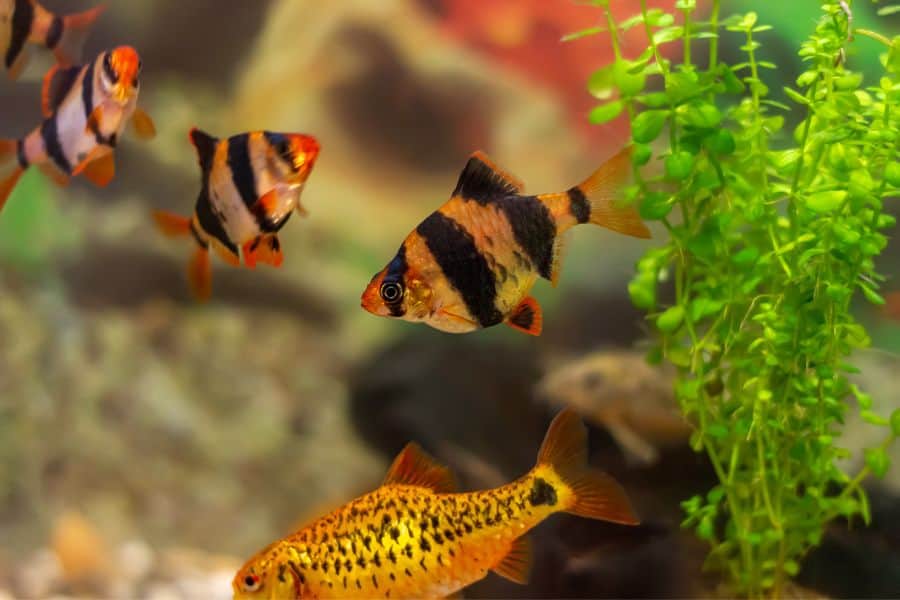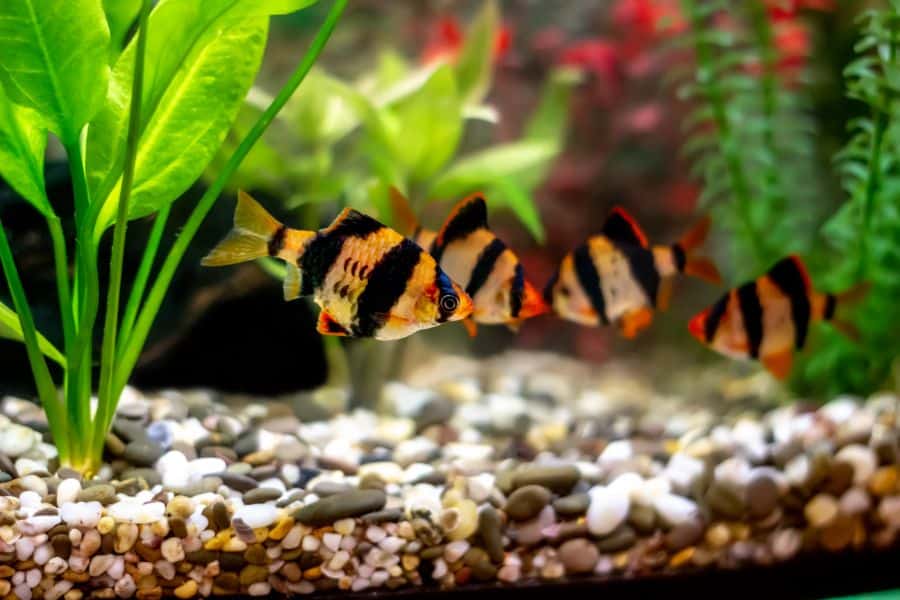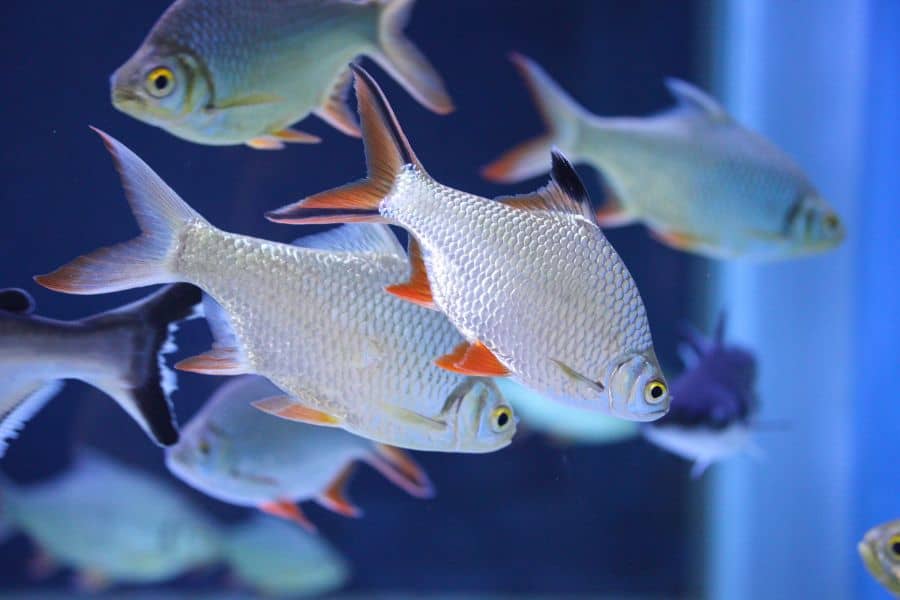Barb fish have been popular aquarium pets for many years, and they continue to be a favorite among fish keepers. These small, colorful fish are known for their active behavior and interesting personalities.
With so many different species of Barb fish to choose from, it can be overwhelming to decide which one is right for you.
We shall examine the numerous Barb fish species that are offered in the aquarium industry in this post, along with their physical traits, suitable tank settings, feeding habits, and distinctive behaviors.
This post will bring valuable information to assist you in selecting the ideal Barb fish for your aquarium, whether you are a novice or a seasoned aquarist.
Barb Fish Overview
Freshwater fish belonging to the barb fish family are renowned for their vivid colors, active lifestyles, and intriguing personalities. They may be found in a range of settings, from slow-moving rivers to fast-flowing streams, and are indigenous to Asia, Africa, and Europe.
Barb fish is a popular choice for novice aquarists due to their reputation for hardiness and ease of maintenance. Barb fish varies in length from little varieties that measure just a few centimeters long to bigger species that can grow to be 30 centimeters long.
Also, they come in a variety of colors, from vivid reds and oranges to rich blues and greens. Barb fish species may stand out in an aquarium due to distinguishing characteristics like stripes or spots.
The capacity of Barb fish to form schools is one of its distinguishing characteristics. They frequently form large groups in the wild for social interaction and safety.
Barb fish prefer to be in clusters of at least 6 other fish in the tank, and it’s fun to watch them connect and move about. Ultimately, Barb fish are a fantastic option for any aquarist wishing to add a lively, eye-catching, and low-maintenance fish species to their aquarium.
18 Types of Barbs
1. Tiger Barb
- Scientific name: Puntigrus tetrazona
- Size: 2.8–3.9 inches
- Lifespan: 5-7 years
- Tank temperature: 77-82 °F
Tiger Barbs have brilliant orange, black, and white stripes all over their body, giving them a stunning look. When nurtured in good habitat, they may reach a length of around 2.8–3.9 inches and have a lifetime of about 5-7 years.
They are gregarious fish that join together in big schools for both social interaction and safety in the environment. They thrive in groups of at least six fish when housed in aquariums since it enables them to display their natural habits and decreases hostility against other fish.
Tiger Barbs are regarded as semi-aggressive fish and occasionally nibble at the fins of other aquarium fish. By providing enough hiding spots and adequate room for every fish to set up their territories, this tendency may be reduced.
They have a varied diet that includes flakes, pellets, and live or frozen meals like brine shrimp and bloodworms. They are omnivorous in nature. They should only be fed as much food as they can consume in a few minutes twice a day.
Tiger Barbs like water with a pH range of 6.0-8.0 that leans slightly acidic to neutral with a hardness of 5–19 dGH. They need to be kept in a tank that is between 77 and 82 degrees Fahrenheit.
Albino tiger barbs are a color morph of the regular tiger barb, and are known for their white or pale pink coloration and red eyes. They are considered to be energetic and lively fish, frequently observed swimming around their tank and engaging with other fish.
Albino Tiger Barbs are a top choice for community aquariums since they get along well with other calm fish species. They can reach up to 2-2.4 inches.
Related: Ideal Tank Mates for Your Tiger Barb
2. Cherry Barb
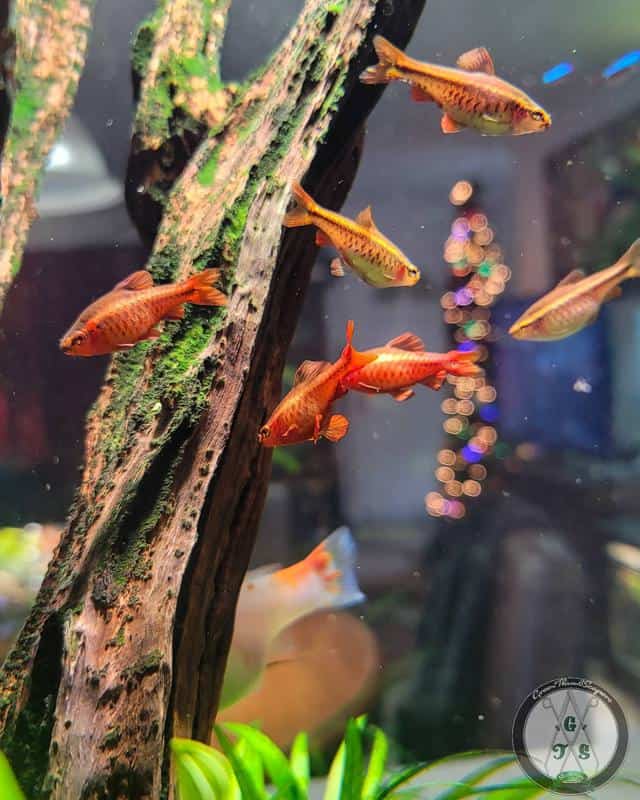
- Scientific name: Puntius titteya
- Size: 2 inches
- Lifespan: 4-7 years
- Tank temperature: 77-82 °F
The majority of the body of Cherry Barbs is brilliant red in color, which gives them their name. When kept in good habitat, they may grow to be around 2 inches long and live for about 4-7 years.
In general, cherry barbs get along well with a wide variety of neighborhood fish. Nevertheless, due to their sensitive fins, which are easily injured, they cannot be kept alongside fish that are aggressive or fin-nipping.
Cherry Barbs are omnivorous and subsist on a varied diet comprising flakes, pellets, and live or frozen foods such as brine shrimp and bloodworms.
Cherry Barbs thrive in slightly acidic to neutral water conditions with a pH range of 6.0-8.0 and a water hardness of 5-15 dGH. To maintain optimal health, their aquarium should be kept at a temperature range of 73-81°F.
3. Rosy Barb
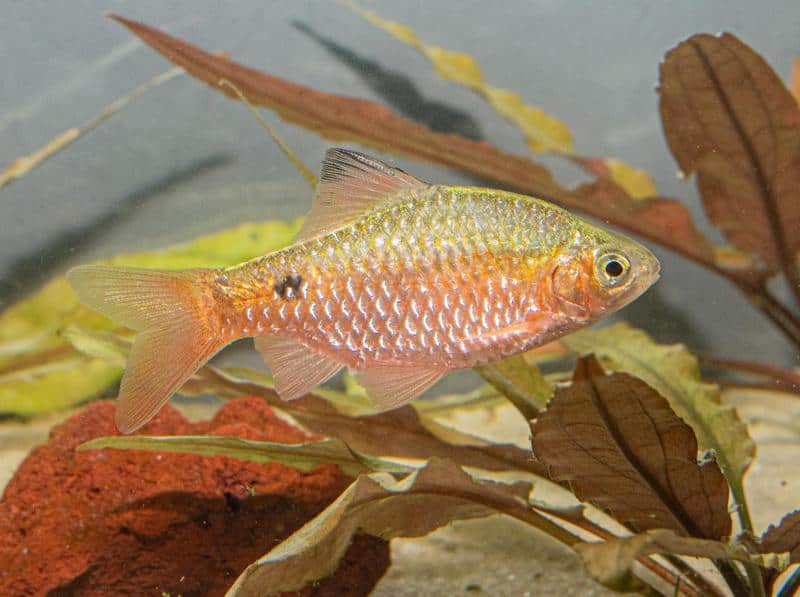
- Scientific name: Pethia conchonius
- Size: 6 inches
- Lifespan: 5 years
- Tank temperature: 64-72 °F
The Rosy Barb, scientifically known as Pethia conchonius, is a popular freshwater fish native to Southern Asia. They are named for their bright pink or red coloration, which covers most of their body.
They are also known for their active and playful behavior, which makes them a favorite among aquarium enthusiasts. Rosy Barbs grow to be around 6 inches in length and have a lifespan of around 5 years.
Rosy barbs are an excellent choice for aquarists of all skill levels since they require little care and can adapt to a variety of water conditions. They are strong fish as well, making them a great choice for new hobbyists.
When it comes to water parameters, Rosy Barbs like a slightly alkaline to neutral pH range of 6.5-7.5 and a water hardness of 5-19 dGH. They must be housed in an aquarium with a temperature range of 64-72°F.
4. Odessa Barb
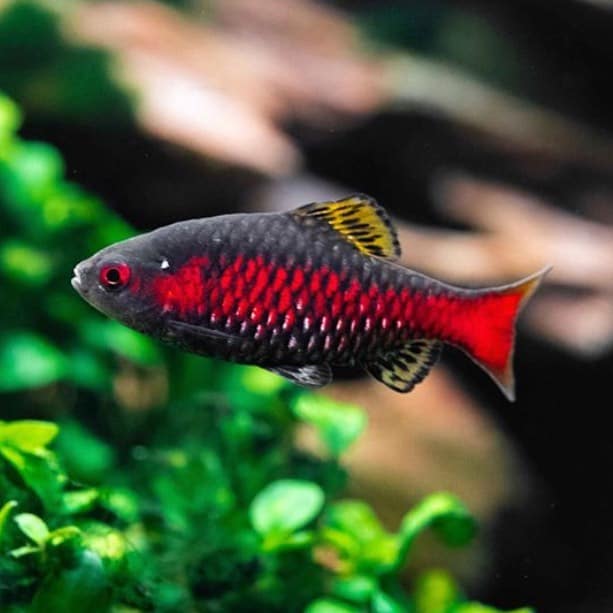
- Scientific name: Pethia padamya
- Size: 1.8-2.8 inches
- Lifespan: 3-5 years
- Tank temperature: 70-78 °F
The Odessa Barb, scientifically called Pethia padamya, is a popular freshwater fish found in the waterways and streams of Myanmar. It is named after the city of Odessa in Ukraine, where the first specimens of fish were imported for the aquarium trade in the 1960s.
Distinguished by their vivid and brilliant coloration, Odessa Barbs showcase a metallic blue-green body with bold orange-red stripes embellishing their fins. They are comparatively diminutive, with a maximum length of 1.8-2.8 inches, and have a lifespan of approximately 3-5 years in captivity.
In the wild, Odessa Barbs are a schooling species that are typically found in fast-moving streams and rivers with rocky substrates. They are active swimmers and require plenty of swimming space in the aquarium.
Due to their omnivorous nature, Odessa Barbs will eat a wide range of meals, including flakes, pellets, and live or frozen items like brine shrimp and daphnia.
In terms of water conditions, Odessa Barbs prefer a slightly acidic to neutral pH range of 6.0-7.0, and a water hardness of 2-10 dGH. They should be kept in a tank with a temperature range of 70-78°F.
5. Tinfoil Barb
- Scientific name: Barbonymus schwanenfeldii
- Size: 14 inches
- Lifespan: 10-15 years
- Tank temperature: 72-77 °F
The Tinfoil Barb, Barbonymus schwanenfeldii in scientific terminology, is a well-known freshwater fish that is indigenous to Southeast Asia, specifically Thailand, Malaysia, and Indonesia. It is a huge, energetic fish that may reach a length of 14 inches and, with proper care, live for more than ten years.
The name “Tinfoil Barbs” refers to the color of these barbs, which is a metallic silver that is extremely shiny and mimics the sheen of tin foil. They also have striking red or orange dorsal and anal fins, which in mature males may get fairly long.
In the wild, Tinfoil Barbs are schooling fish that inhabit fast-moving rivers and streams with plenty of open space for swimming. They are highly active and require a large aquarium of at least 100 gallons to accommodate their size and swimming needs.
If they are not given enough room to set up their own territory, Tinfoil Barbs can become territorial and hostile against other fish. In addition to flakes and pellets, Tinfoil Barbs will also eat live or frozen shrimp and worms. They are omnivorous and will eat a range of foods.
Tinfoil Barbs require water that is between 6.5 and 7.0 pH, slightly acidic to neutral, and 5 to 15 dGH in hardness. They have to be kept in a tank with a 72–77°F temperature range.
6. Gold Barb
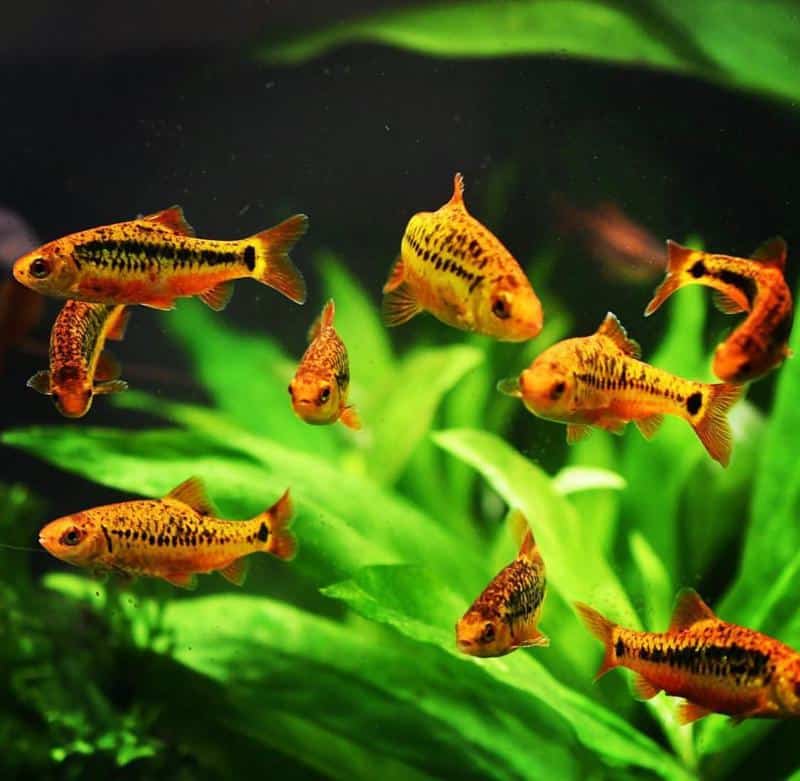
- Scientific name: Barbodes semifasciolatus
- Size: 2.8 inches
- Lifespan: 4-6 years
- Tank temperature: 62-75 °F
The Gold Barb, scientifically known as Barbodes semifasciolatus, is a popular freshwater fish that is native to the rivers and streams of Southeast Asia, specifically China, and Vietnam. As their name suggests, Gold Barbs are known for their bright golden coloration, which is more intense in males during the breeding season.
A fairly tiny species, gold barbs can reach lengths of up to 2-2.8 inches and live for up to 4-6 years in tanks.
In the wild, Gold Barbs are a schooling species that are typically found in slow-moving streams and rivers with a sandy or muddy substrate. They are active swimmers and require plenty of swimming space in the aquarium.
Gold Barbs do best in a planted aquarium with plenty of hiding places since they can be shy and may feel safer with places to hide. Due to their omnivorous nature, gold barbs will eat a range of meals, including flakes, pellets, and live or frozen items like brine shrimp and bloodworms.
Gold Barbs prefer water conditions with a slightly acidic to neutral pH range of 6.0-8.0 and a water hardness of 5-12 dGH. To maintain ideal health, they should be housed in a tank with a temperature range of 62-75°F.
7. Checker Barb
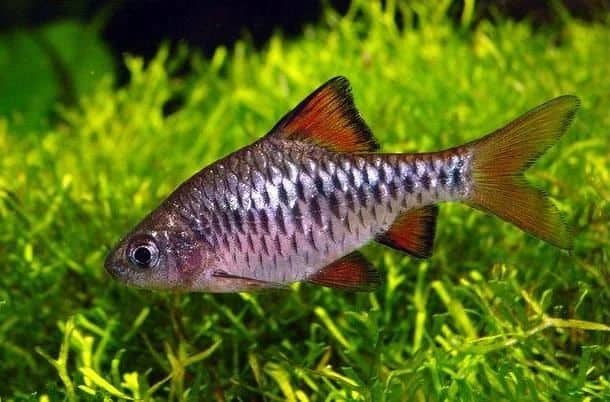
- Scientific name: Oliotius oligolepis
- Size: 2 inches
- Lifespan: 8 years
- Tank temperature: 68-75 °F
The Checker Barb is a tiny, calm freshwater fish that is indigenous to the rivers and streams of India. Its scientific name is Oliotius oligolepis. Because of its striking black and white checkerboard design, which stands out in an aquarium, it is a preferred option among aquarists.
In captivity, Checker Barbs may reach lengths of around 2 inches and live for about 8 years.
In the wild, Checker Barbs are found in clear, flowing waters with sandy or gravelly substrates. They are active swimmers and require plenty of swimming space in the aquarium.
These omnivores will consume flakes, pellets, as well as live or frozen items like brine shrimp and redworms.
With a pH range of 6.0-6.5 and water hardness of 10 dGH, Checker Barbs enjoy mildly acidic to moderate water conditions. They should be kept in a tank with a 68–75°F temperature range.
8. Snakeskin Barb
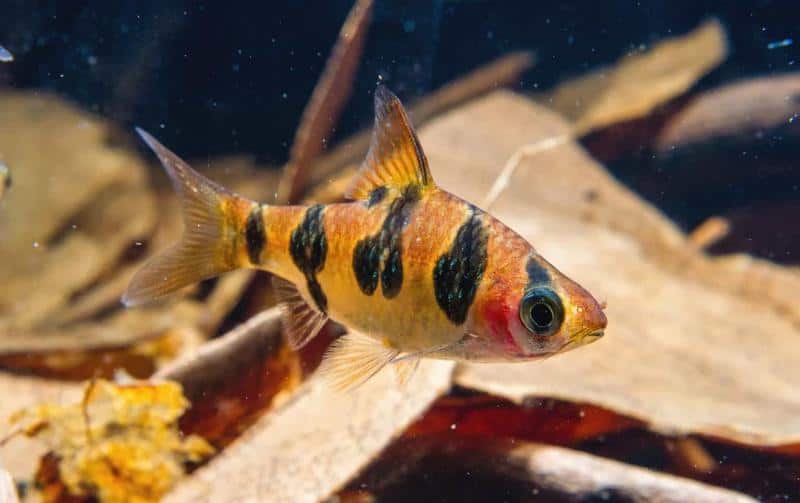
- Scientific name: Puntius rhombocellatus
- Size: 3.5 inches
- Lifespan: 5-8 years
- Tank temperature: 73-82°F
Native to Southeast Asia, especially Thailand and Malaysia, the Snakeskin Barb, scientifically known as Puntius rhombocellatus, is a small and amiable freshwater fish species, recognized for its distinctive scale design that mimics a snake’s pattern.
The lifespan of a snakeskin barb in a tank is around 5-8 years, and they may reach lengths of up to 3.5 inches.
Snakeskin Barbs can be discovered in the wild in ponds and streams with muddy or sandy bottoms. They need a lot of swimming room in the aquarium since they are aggressive swimmers.
However, it’s essential to pay attention that Snakeskin Barbs are infamous for jumping; thus, keeping the tank well-covered is advised to stop any unintentional escapes.
These fish prefer a planted aquarium with plenty of hiding spots to provide security. Snakeskin Barbs are omnivores and will accept a variety of foods, including flakes, pellets, and live or frozen foods such as brine shrimp and bloodworms.
These species prefer water with a pH range of 5.5-6.5 and a water hardness of 5-7 dGH, which are mildly acidic to neutral. The ideal water temperature for snakeskin barbs is between 73 and 82 degrees Fahrenheit.
9. Filament Barb
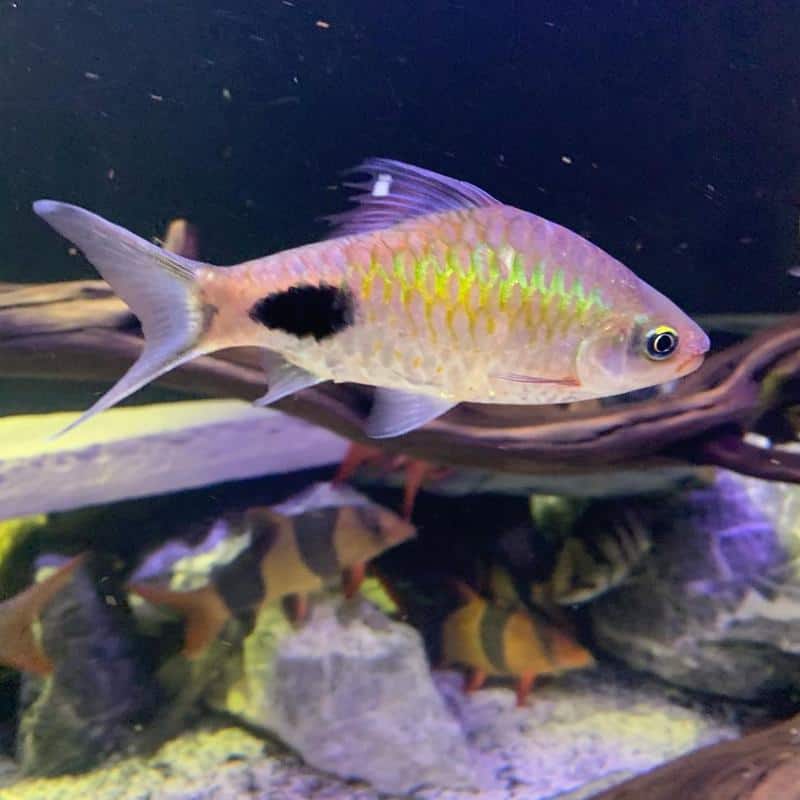
- Scientific name: Dawkinsia filamentosa
- Size: 6-7 inches
- Lifespan: 2-8 years
- Tank temperature: 72-79°F
The Filament Barb, also known by its scientific name Dawkinsia filamentosa, is a freshwater fish species that are native to the Western Ghats of India. It is a peaceful and active swimmer that is popular among aquarium enthusiasts due to its striking appearance and peaceful nature.
The Filament Barb is a fairly small species with a life expectancy in captivity of around 2-8 years and a maximum length of about 6–7 inches.
Filament Barbs are creatures that live in rivers and streams that have rocky or sandy bottoms. They need a lot of swimming room in the aquarium since they are aggressive swimmers.
These fish are omnivores and will eat shavings, pellets, as well as live or frozen items like brine shrimp and bloodworms. Filament Barbs prefer a pH range of 5.5-7.0, a water hardness of 5-12 dGH, and a tank with a temperature range of 72-79°F.
The long, thread-like extensions that extend from the Filament Barb’s dorsal and anal fins are one of its most recognizable characteristics. During breeding, these appendages serve to attract mates and can grow to many times that of the fish.
10. Clown Barb
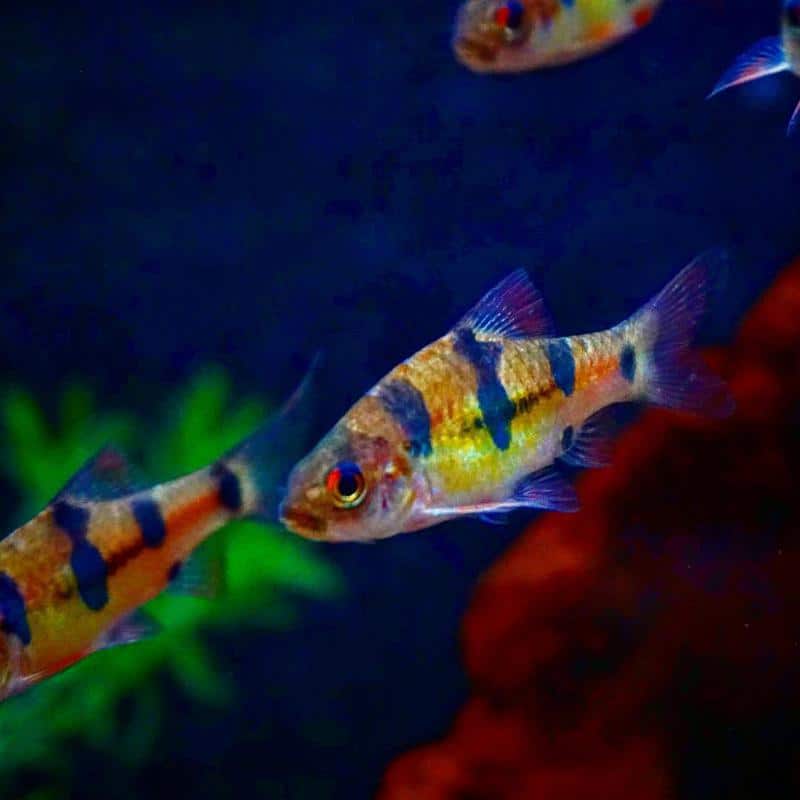
- Scientific name: Barbodes everetti
- Size: 5-5.9 inches
- Lifespan: 4-8 years
- Tank temperature: 79-82 °F
Freshwater fish endemic to Borneo, Indonesia, and Malaysia are called clown barbs, also known by the scientific name Barbodes everetti. Because of its vibrant colors and energetic nature, this fish is vivacious and beautiful and is a favorite among aquarium aficionados.
In tanks, clown barbs may reach lengths of up to 5–5.9 inches and can live for up to 4-8 years. Clown Barbs are typically found in slow-moving rivers and streams with rough or gritty bottoms.
They need a lot of swimming room in the aquarium since they are aggressive swimmers. Clown Barbs require water with a pH range of 6.0-7.0 and a water hardness of 5-12 dGH. They have to be kept in a tank with a 79–82°F temperature range.
The Clown Barb’s colors are among its most defining characteristics. Usually, silver or light yellow in color, the fish’s body has orange-red stripes running horizontally along it. The fish’s fins have black and orange patterns and are similarly vividly colored.
11. Arulius Barb
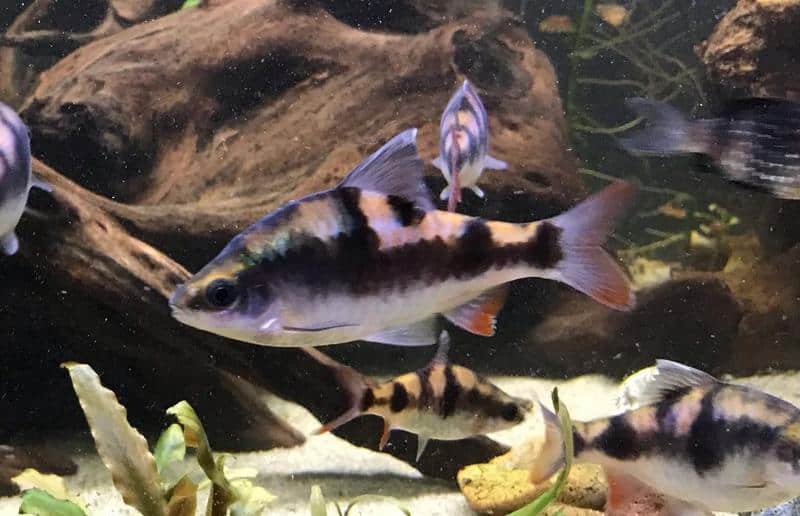
- Scientific name: Dawkinsia arulius
- Size: 4.7 inches
- Lifespan: 4-6 years
- Tank temperature: 66-77 °F
The Arulius Barb also described as Dawkinsia arulius, is a well-liked freshwater fish species among aquarium hobbyists. It is indigenous to India and is located in the Western Ghats’ streams and waterways.
The Arulius Barb has an elongated, thin body that is silver in color with black patterns all around it. It may have a maximum length of 4.7 inches and live in tanks for up to 6 years.
In the aquarium, the Arulius Barb prefers a planted tank with plenty of swimming space. They are omnivorous and will accept a variety of foods, including flakes, pellets, and live or frozen foods such as brine shrimp and bloodworms.
The Arulius Barb prefers slightly acidic to neutral water conditions, with a pH range of 6.0-6.5 and a water hardness of 5-10 dGH. They should be kept in a tank with a temperature range of 66-77°F.
It is worth noting that Arulius Barbs are prone to fin nipping, particularly if kept in small groups or alongside fish with lengthy fins. Thus, it is crucial to offer numerous hiding spots and adequate swimming space to reduce stress and avert aggressive behavior.
12. Fiveband Barb
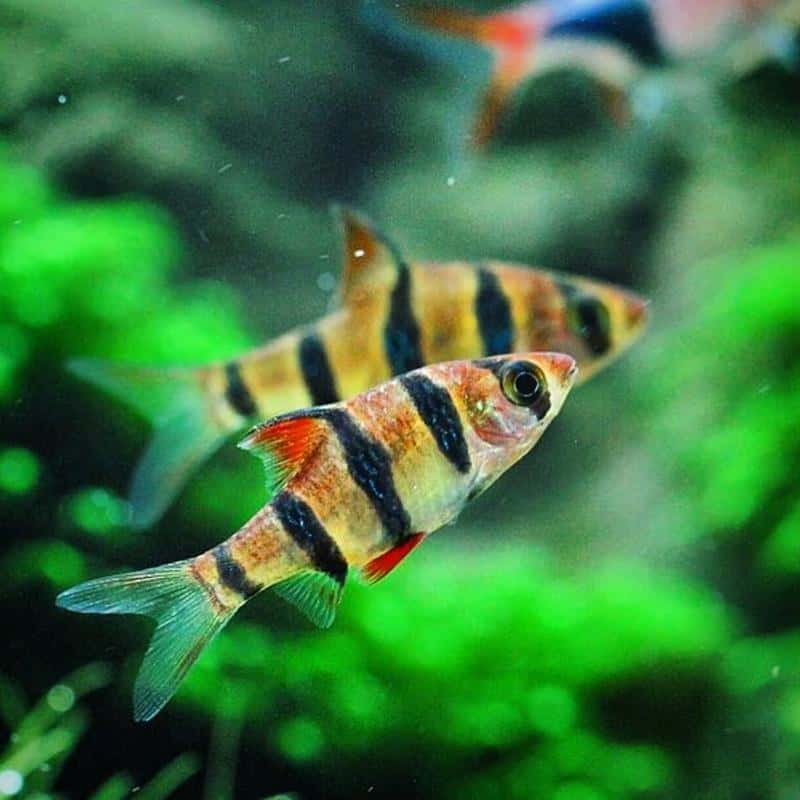
- Scientific name: Desmopuntius pentazona
- Size: 3.5 inches
- Lifespan: 5 years
- Tank temperature: 74-84 °F
The Five Band Barb, also known as Desmopuntius pentazona, is a well-known freshwater fish species that are endemic to Southeast Asia, namely in the rivers of Indonesia, Thailand, and Malaysia. It is an excellent fish for community aquariums since it is calm and energetic.
With five black horizontal stripes throughout its brilliant yellow-gold body, the Five-band Barb has a distinctive and eye-catching look. Reddish-orange colored lateral and anal fins, as well as a forked posterior fin, are present.
It has a lifespan of 5 years while held captive and may grow up to 3.5 inches in length. They are omnivorous and will eat a range of foods, including shavings, pellets, and fresh or frozen delicacies like brine shrimp and blackworms.
The Five-band Barb prefers slightly acidic to neutral water conditions, with a pH range of 5.0-6.0 and a water hardness of 5-12 dGH. They should be kept in a tank with a temperature range of 74-84°F.
13. Black Ruby Barb
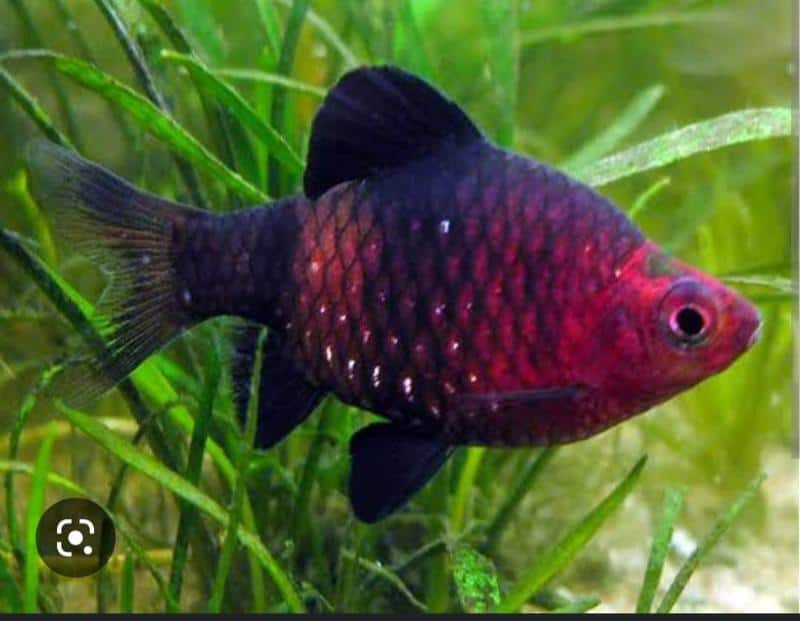
- Scientific name: Pethia nigrofasciata
- Size: 2-3 inches
- Lifespan: 3-5 years
- Tank temperature: 72-79 °F
Black Ruby Barb is a small and attractive fish that belongs to the family of Cyprinidae. It is scientifically known as Pethia nigrofasciata and is native to Sri Lanka.
Because of their gorgeous coloration and calm personalities, these fish are highly well-liked among aquarium lovers. Black Ruby Barbs may reach lengths of up to 2-3 inches and can live for 3-5 years on average.
Its characteristic black and red color oxidizes during the mating season. Fish that are males are more brilliantly colored and have deeper red tones.
Black Ruby Barbs may be found in slow-moving streams and ponds with plenty of vegetation as part of their native environment. These omnivorous fish consume plant material, tiny crustaceans, and insects.
They may be given a variety of diets in the aquarium, including flakes, pellets, and live or frozen items. By establishing a separate breeding tank with the proper water conditions, Black Ruby Barbs may be bred rather easily.
14. Spanner Barb
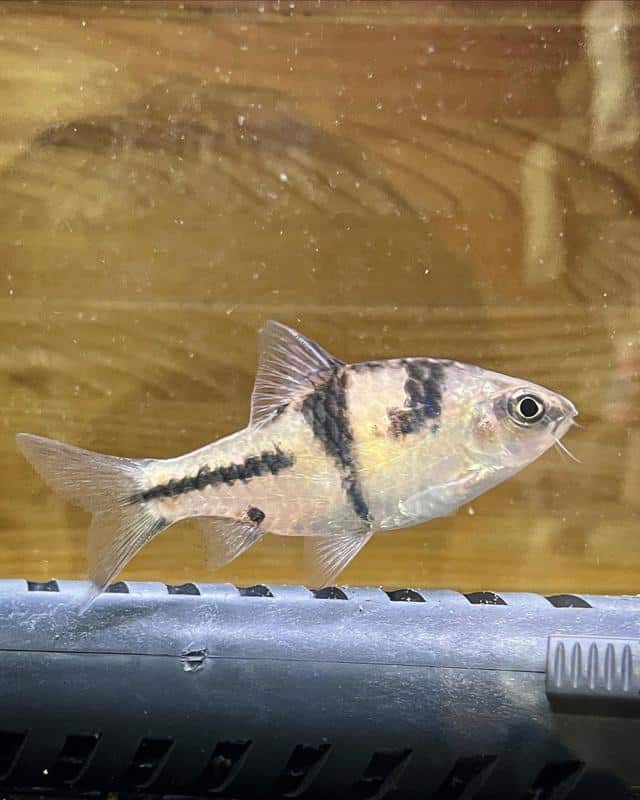
- Scientific name: Barbodes lateristriga
- Size: 7.1 inches
- Lifespan: 2-4 years
- Tank temperature: 77-82 °F
The Spanner Barb, also referred to as T-barb or Tinfoil Barb and scientifically named Barbodes lateristriga, is a type of freshwater fish belonging to the Cyprinidae family. It can be found in tropical areas of Southeast Asia, particularly in Thailand, Cambodia, and Laos.
The Spanner Barb (Puntius lateristriga) is distinguished by its barrel-shaped body, silver or gold color, and black dorsal, ventral, and perineal fins. While it may grow to a length of up to 14 inches in the wild, in tanks it usually reaches a size of 7.1 inches.
This species has a maximum lifetime of 8 years. The Spanner Barb needs a sizable aquarium with plenty of swimming room since it is an aggressive swimmer.
It is advised to provide a group of these fish with a spacious tank that is at least 75 gallons in size to keep them healthy and happy. They flourish in warm water with a temperature range of 75-82°F (24-28°C), and they require a pH level of 7.2, which is slightly acidic to neutral.
This species consumes plant materials, crustaceans, and insects in the wild. They may be given a variety of flake, pellet, and frozen meals while being supplemented with live feeds such as brine shrimp or bloodworms when kept in captivity.
This species is generally peaceful and can be kept in a community aquarium with other non-aggressive fish species of similar size. However, it may nip at the fins of slower-moving tankmates, such as angelfish or guppies.
15. African Banded Barb
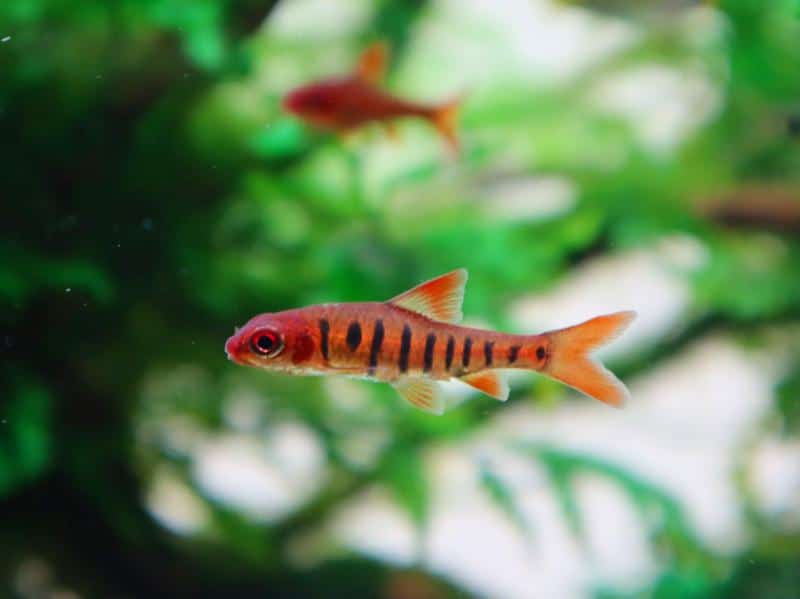
- Scientific name: Enteromius fasciolatus
- Size: 7.1 inches
- Lifespan: 3-5 years
- Tank temperature: 71-78 °F
Freshwater fish, also known as the African Banded Barb or Enteromius fasciolatus, are indigenous to various countries across Africa, including Mozambique, Tanzania, and Zambia. Due to its appealing look and calm demeanor, it is a well-liked tank fish.
The African Banded Barb typically grows to a size of about 7.1 inches and has a lifespan of around 5 years in captivity. It is an omnivorous fish and will eat a variety of foods, including flakes, pellets, and live or frozen foods such as brine shrimp and bloodworms.
In the wild, the African Banded Barb is found in rivers and streams with moderate to strong currents. Therefore, it is recommended to provide a well-filtered aquarium with plenty of hiding spots and moderate water flow to mimic their natural environment.
Breeding African Banded Barbs can be accomplished in a separate breeding tank with slightly acidic to neutral water and a temperature of around 71-78°F. The male will typically chase the female around the tank, leading her to a spawning site where she will release her eggs.
The eggs will hatch in between 24 and 48 hours, and the fry could be given infusoria or shavings that have been finely ground until they are big enough to eat conventional fish food.
16. Chubby Head Barb
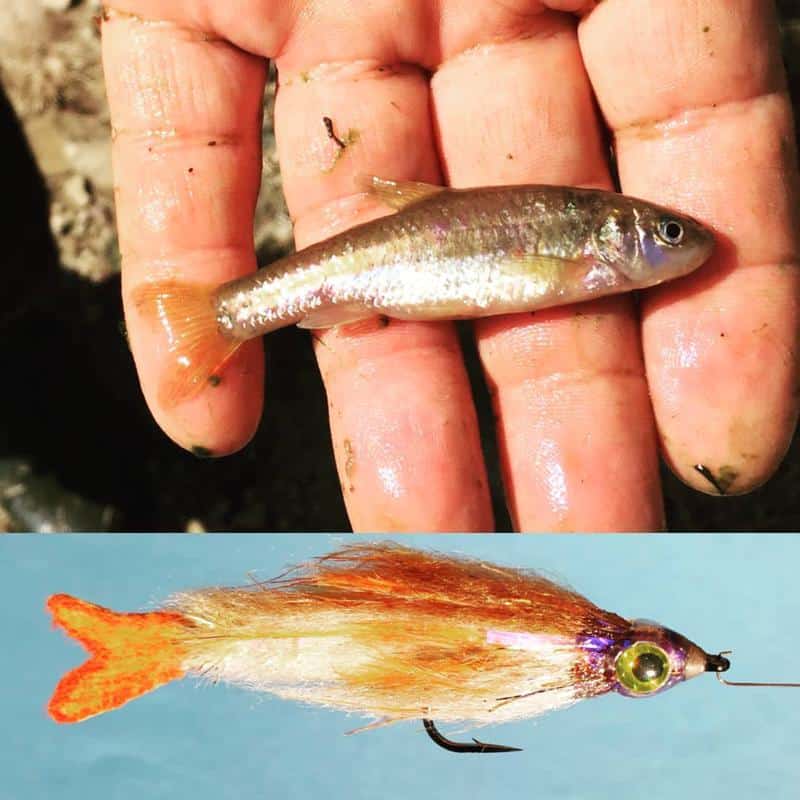
- Scientific name: Enteromius anoplus
- Size: 3.9-4.7 inches
- Lifespan: 2-4 years
- Tank temperature: 41-71 °F
The Chubby Head Barb, scientifically known as Enteromius anoplus, is a freshwater fish species that originates from the river systems of Southeast Asia, mainly in Thailand, Malaysia, and Indonesia. This species is distinguished by its peculiar and appealing look due to having a big head in proportion to its body.
Chubby Head Barbs may reach lengths of up to 4.7 inches; thus, a sizable tank is necessary to house them. It is advised to give them a lot of swimming room along with a cover, including driftwood and plants.
Chubby Head Barbs are omnivores and will eat a range of foods, including phytoplankton, and detritus, as well as live and frozen items like crustaceans and insects. To make sure they get all the nutrients they need, it is advised to provide them with a diversified diet.
Chubby Head Barb requires water that is between 41 and 71 degrees Fahrenheit, 6.0 to 7.5 on the pH scale, and 5 to 12 dGH in terms of water hardness. To ensure excellent water quality, regular water changes and filtration are required.
The Chubby Head Barb has an intriguing feature whereby males grow larger fins and a brighter color during mating. The female would deposit hundreds of eggs on the ground, which will be fertilized by the male.
17. Greenstripe Barb
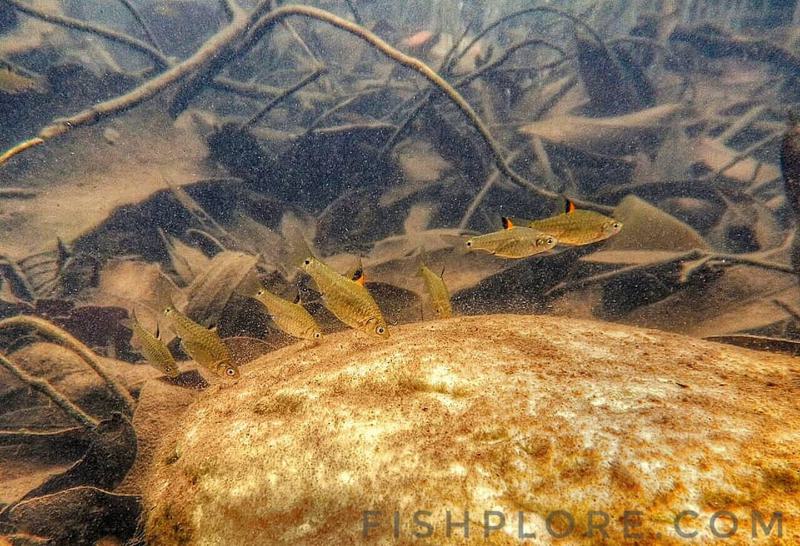
- Scientific name: Puntius vittatus
- Size: 2 inches
- Lifespan: 2-4 years
- Tank temperature: 68-75 °F
The Greenstripe Barb, also known as Puntius vittatus, is a freshwater fish species that are native to South Asia, particularly in India and Sri Lanka. This species is popular among aquarium hobbyists due to its beautiful and vibrant green stripes that run along its body.
Greenstripe Barbs are comparatively small, expanding up to 2 inches long, and they are calm and active fish that are best kept in pairs of at least 6. These might be a fantastic option for beginning aquarists because they are easy to maintain.
An average temperature of 68–75°F, a pH range of 6.0–765, and water hardness of 8–12 dGH are only a few of the requirements for the growth of Greenstripe Barbs in water.
Although it might be difficult, breeding Greenstripe Barbs in a home aquarium is possible. On the substrate, the female will deposit eggs that the male will fertilize. The eggs will hatch in 24 to 36 hours; the fry can then be fed freshly born brine shrimp to ensure normal growth and development.
18. Redside Barb
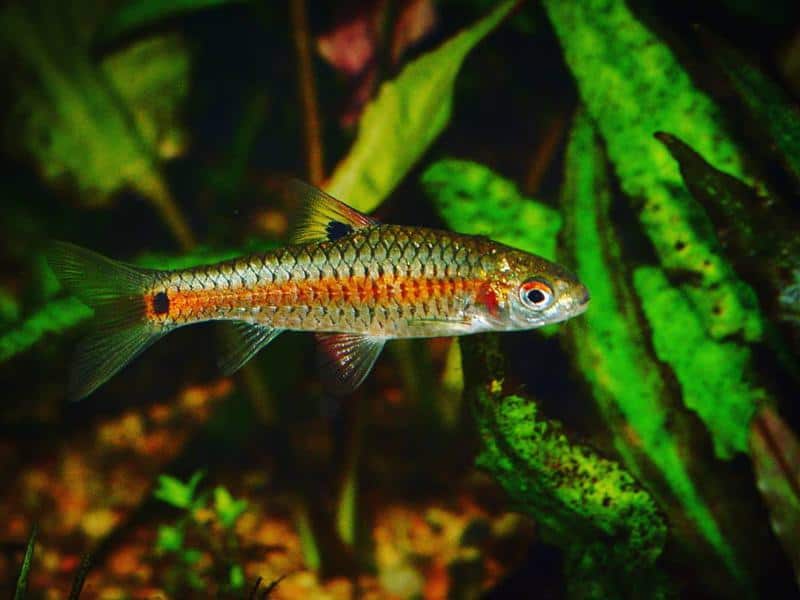
- Scientific name: Puntius bimaculatus
- Size: 2.7 inches
- Lifespan: 2-4 years
- Tank temperature: 64-75 °F
Puntius bimaculatus sometimes referred to as the Two-spot Barb, is a freshwater species that belongs to the Cyprinidae family. It is indigenous to nations in southern and southeastern Asia, such as India, Nepal, Bangladesh, and Burma.
The Two-spot Barb has a distinctive black spot on its torso, just behind the gills, and second on the bottom of its tail fin. The rest of its body is generally silver or golden in color.
The maximum length of this fish, which can live up to five years, is 2.7 inches. The Two-spot Barb lives in slow to moderate flowing freshwater rivers and streams in the wild.
Like other peaceful fish species of comparable size, this type of peaceful swimmer may be kept in community aquariums. It is advised to keep these fish in small groups in tanks that are at least 20 gallons in size. This fish needs water parameters between 18 and 24 °C (64 and 75 °F) in temperature and between neutral and slightly acidic in pH.
A planted aquarium with hiding spots and open swimming spaces will provide an optimal environment for these fish.
Read More:
FAQs
What Size Tank Do Barb Fish Need?
The size of the tank needed for barb fish depends on the specific type of barb and the number of fish you plan to keep. In general, a minimum tank size of 20 gallons is recommended for most barb species.
Do Barb Fish Require a Lot of Care?
Barb fish are generally hardy and easy to care for. They require a suitable tank with proper filtration and regular water changes. Providing a balanced diet and monitoring their behavior can help ensure their health and well-being.
What Is the Most Peaceful Barb Fish?
The Cherry Barb (Puntius titteya), one of the numerous varieties of barb fish, is renowned for its peaceful personality. These are an excellent addition to any community tank since they are compact and simple to maintain.
Nonetheless, it is crucial to remember that each fish has its own personality, and regardless of their species, some fish may be more aggressive than others.
Conclusion
Barb fish are a fascinating group of freshwater fish that offer a lot of variety to aquarium enthusiasts. From the colorful and peaceful Cherry Barb to the larger and more active Tinfoil Barb, there are barb species for every aquarist.
Barb fish are generally hardy and easy to care for, although some species may require specific water parameters or diets. As always, it’s important to research the specific needs of your chosen species before setting up your aquarium.
With the right conditions and care, barb fish can thrive in any aquarium and provide endless entertainment for their owners.
